The Association of Gender, Book Bag Style, and Back Pain Among University Students
Abstract
The purpose of this cross-sectional study is to identify risk factors associated with book bag carriage among college students and discuss strategies for prevention. A nine-question survey and demographic form was administered to study respondents (n= 222). Forty six percent of respondents reported pain in the shoulders, and 37% of respondents reported pain in the lower back. The data shows that of the effective 222 respondents, almost 62% reported pain. Thirty percent of respondents reported pain at multiple locations of the body followed by 14% shoulder and 12% lower back pain. The range for book bag carriage weight was 2.5 lbs. to 25 lbs. Style of book bag, respondent gender, and book bag weight were determinates for self-reported pain. There are several significant findings associated with the study. Female respondents self-reported pain at a higher rate than males. A chi-square test was used to determine whether there is a significant difference between self-reported pain by respondent gender. The difference between these variables was significant, χ 2 (1, N = 222) = 8.2019, p= 0.0042. These results suggest that risk factors such as gender, weight, and style of book bag may play a role in self-reported back pain among college students.
Introduction
The purpose of this cross-sectional study is to identify risk factors associated with book bag carriage among college students and discuss strategies for prevention. A nine-question survey and demographic form was administered to study respondents (n= 222). Forty six percent of respondents reported pain in the shoulders, and 37% of respondents reported pain in the lower back. The data shows that of the effective 222 respondents, almost 62% reported pain. Thirty percent of respondents reported pain at multiple locations of the body followed by 14% shoulder and 12% lower back pain. The range for book bag carriage weight was 2.5 lbs. to 25 lbs. Style of book bag, respondent gender, and book bag weight were determinates for self-reported pain. There are several significant findings associated with the study. Female respondents self-reported pain at a higher rate than males. A chi-square test was used to determine whether there is a significant difference between self-reported pain by respondent gender. The difference between these variables was significant, χ 2 (1, N = 222) = 8.2019, p= 0.0042. These results suggest that risk factors such as gender, weight, and style of book bag may play a role in self-reported back pain among college students.
The cross-sectional study examined the following research hypotheses (null hypothesis).
- There is no difference in perceived self-reported pain based on respondent gender
- There is no difference in respondent perceived self-reported pain, style of book bag
- There is no difference between on-campus and off-campus respondents reporting of perceived pain
Concerns have often been raised by parents, researchers, and health professionals over heavy book bags carried by children and young adults. These problems may be a significant factor in the development of young adults and may place them at greater risk of ergonomic-related disorders (Pascoe, et al., 1997). However, little is known regarding the association between college-aged students and risk factors associated with injury due to book bag carriage. Every day, thousands of students carry book bags and purses filled with books, bottles of water, laptop computers, and other items that may create a strain on their bodies. In 1999, the use of book bags resulted in more than 6,000 injuries in the U.S. (Hamilton, 2001). The adverse effects of book bag weight carriage are well documented. In a study performed in 1997, the mean weight of school book bags was 17% of the student’s mean body weight, and researchers found that the most common symptoms reported in the study were muscle soreness, back pain, numbness, and shoulder pain (Pascoee, Pascoee, Wang, Shim, 1997).
Previous studies have suggested that book bags of 10% of individual body weight are a justified limit based on epidemiological, physiological, and biomechanical approaches (Brackley, Stevenson, 2004). However, this percentage is specific to young children only and lacks consideration of other factors such as book bag design, the increasing prevalence of obesity among the younger population, and distance and period of carrying the book bag. A survey of 1,178 students in France also concluded that the habitual or prolonged carriage of excessive loads might result in lower back pain and musculoskeletal disorders (Troussier, Davoine, De Gaudemaris, 1994).
Moreover, 35% of respondents in a 2005 survey reported the prevalence of lower back musculoskeletal symptoms, even though the mean weight of school bags was 11.7% of body weight (Whittfield J, Legg SJ, Hedderley DI, 2005). Based on previous studies, researchers contend that the prolonged carrying of heavy loads in book bags could lead to symptoms of body soreness, aches, pains, and tiredness (Johnson, Knapik, 1995). Researchers have found a strong correlation between the loads carried in book bags and lower back symptoms. In recent years, a number of studies have investigated physiological and biomechanical responses to load carriage. In one study, a significant increase in oxygen uptake, energy expenditure, and heart rate were associated with excessive load carriage (Hong, Li, Wong, Robinson, 2000).
Research Methods
The cross-sectional study was approved by the Indiana University’s Institutional Review Board. The research design of the descriptive and inferential correlation cross-sectional study examined five (Table 2) different research hypotheses. Specifically, each null hypothesis was tested using an independent t-test, chi-square test, and Fisher’s exact test for significance at the .05 level to test the following research null hypotheses:
- There is no difference in reported pain by respondent gender
- There no difference in respondent perceived self-reported pain by style of book bag among students who reported pain in one specific location
Study population and instruments:
Study respondents were both undergraduate and graduate students enrolled at Indiana University. Researchers collected data on four different days to complete the study. Study instrument: The respondents (n=222) were requested to complete a demographic form and questionnaire. The sample size of the study is a limitation and further research is needed.
The response rate for the study was 89%. The questionnaire and demographic form included 10 items that surveyed respondents’ self-reported pain, location of pain on the body (upper back, lower back, shoulder, neck) frequency of carriage (Monday, Tuesday, Wednesday, Thursday, Friday), style of bag (single strap, double strap, messenger bag), year in school, gender, residence (living on- or off-campus), and frequency of carriage. A Rapala handheld digital scale was used to weigh each book bag and book bag. The electronic scale was calibrated at zero before each respondent’s book bag was weighed. The scale weighs to the nearest ounce up to 50 pounds on an LCD screen. Researchers weighed the load carriage of each respondent’s bag.
Limitations
The survey instrument required self-reporting and was completed in the presence of researchers. This cross-sectional approach collects data at one time. can be difficult to predict the outcome and the presence of researchers can influence respondents’ thoughts, ideas, and responses to questions (Dooley, 1995). The researcher recognizes the need to utilize a validated scale to measure pain. However, since this is a pilot study and the sample size was limited, the researchers considered using a validated pain intensity scale for future studies. According to other researchers, there may be limitations associated with self-reported pain intensity scales in terms of individualized pain tolerances and genetic predisposition to pain perception. There is also biological evidence that individuals are born with various thresholds of pain perception that may influence results associated with using pain intensity scales (Melzack, R, Wall, PD, 1996). Data Analysis: SAS system for Windows software, release 9.3, was used to analyze the participant data (n=222). Descriptive statistics were used to describe the participants’ demographic and environmental characteristics. Additionally, we summarized and reported the responders’ answers to the pain location questions in terms of frequency and proportions. We also identified the top three locations on the body for self-reported pain. A value of P < 0.05 was used as the indicator of statistical significance.
Results
As shown in Table 1, 55% of respondents were female, 68% of study respondents live off campus.
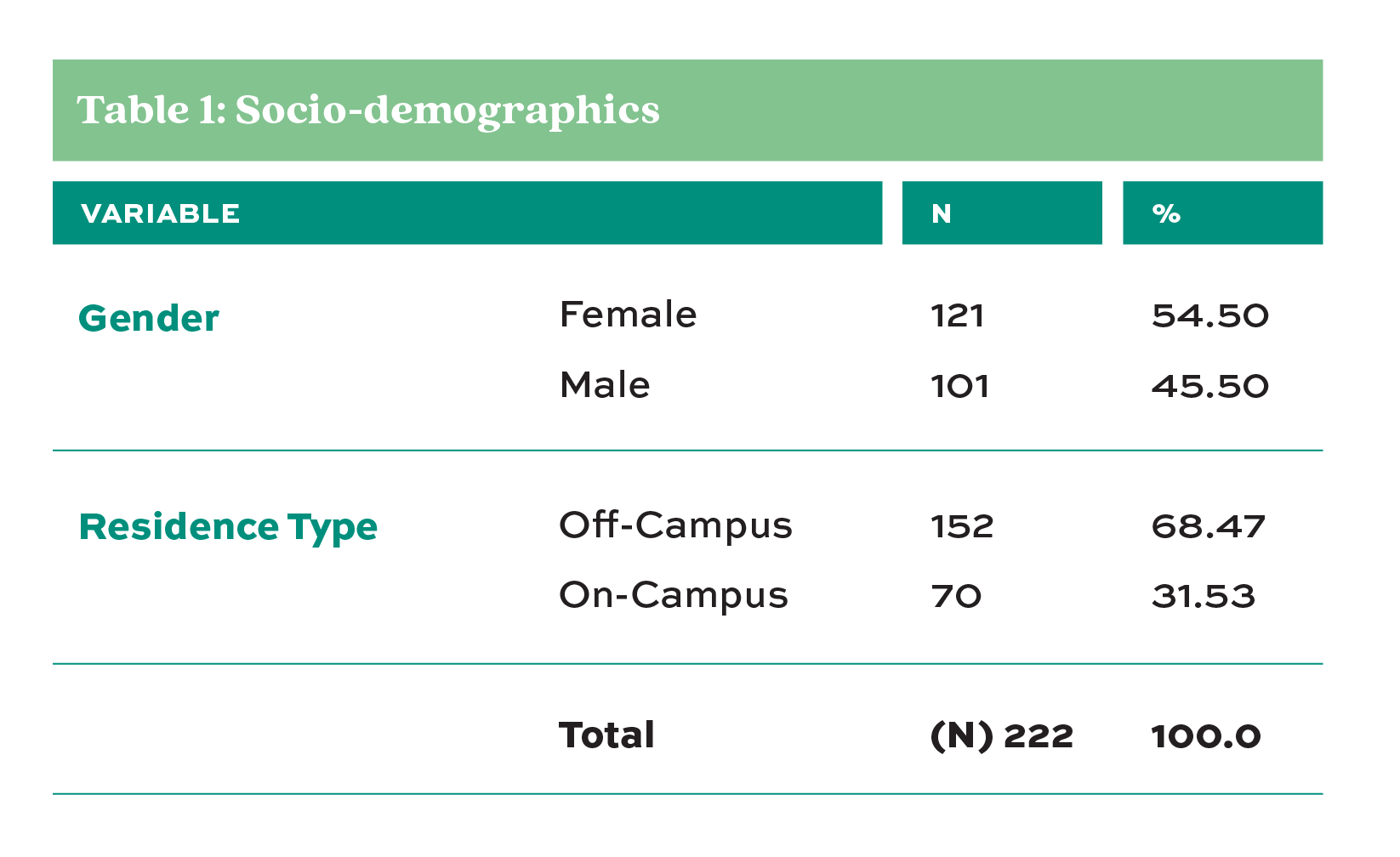
Table 2 describes respondent characteristics. From the 220 effective respondents in Table 2, 90% of respondents carry a book bag four days or more per week; 70% of respondents were undergraduate students, 60% of respondents wore the standard double adjustable book bag, and most of the students were full-time students. The average weight of the book bag students carried was 11.25 pounds with a standard deviation of 4.37. (note that 2 outliers have been removed)
Table 3 shows that 38% of females and 23% of male respondents self-reported pain. As shown in Table 3, a chi-square test was used to determine whether there was a significant difference between self-reported pain by respondent gender. The difference between these variables is significant, χ 2 (1, N = 222) = 8.2019, p= 0.0042.

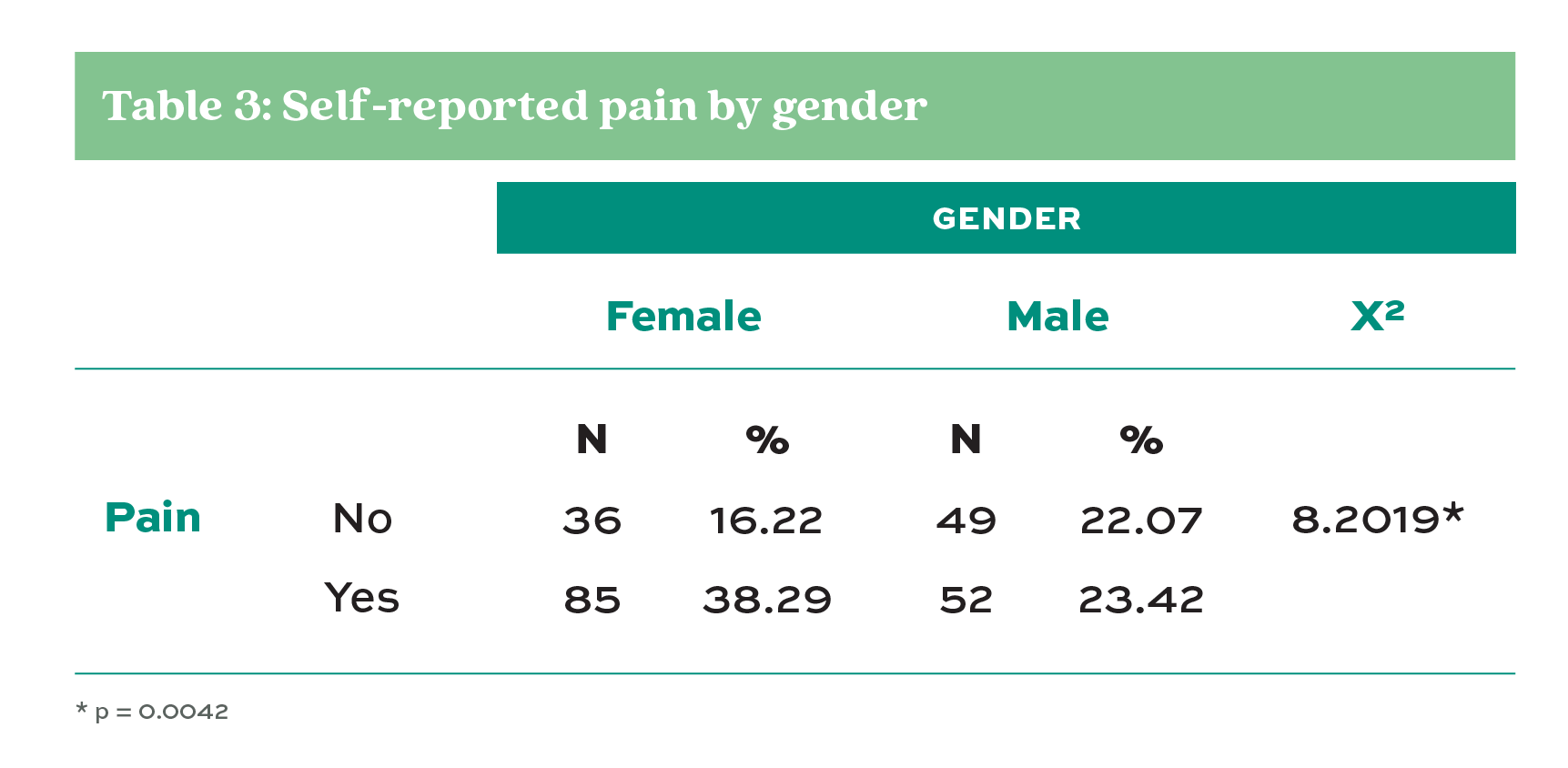
According to the data in Table 4, 46% of respondents reported pain in the shoulders, and 37% of respondents reported pain in the lower back. These locations have been examined in order to identify if the bag style associated with reporting pain is in one of these locations.
A Fisher’s exact test was used to identify the differences between pain locations among students who reported one pain location by two types of bags—one strap and two strap book bags (standard book bag). The results in Table 6 indicate the difference between the pain locations is significant by the bag types, and the p-value for the Fisher’s exact test is p= 0.0013.
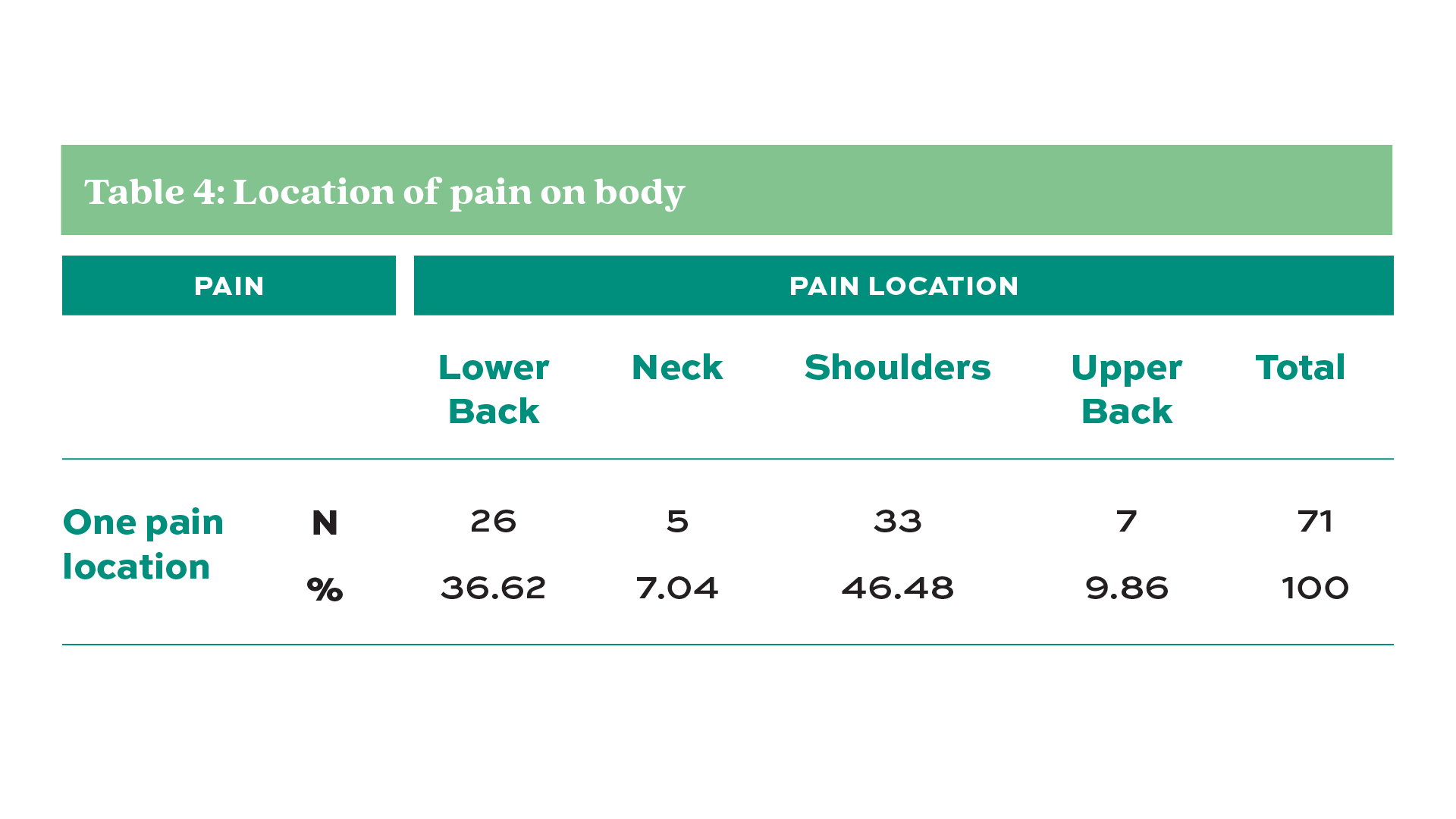

A t-test was used to identify if there was a significant difference between the means of book bag weight (lbs.) for students who reported having pain and those not having pain. The results in Table 6 indicate that there is a significant difference between the mean of book bag weight for students who reported having pain and not having pain (t (220) = -2.52, p = 0.0125). The mean of book bag weight for students who reported having pain (M= 12.24, SD= 5.92) is significantly higher than students who report not having pain (M=10.42, SD= 3.86).
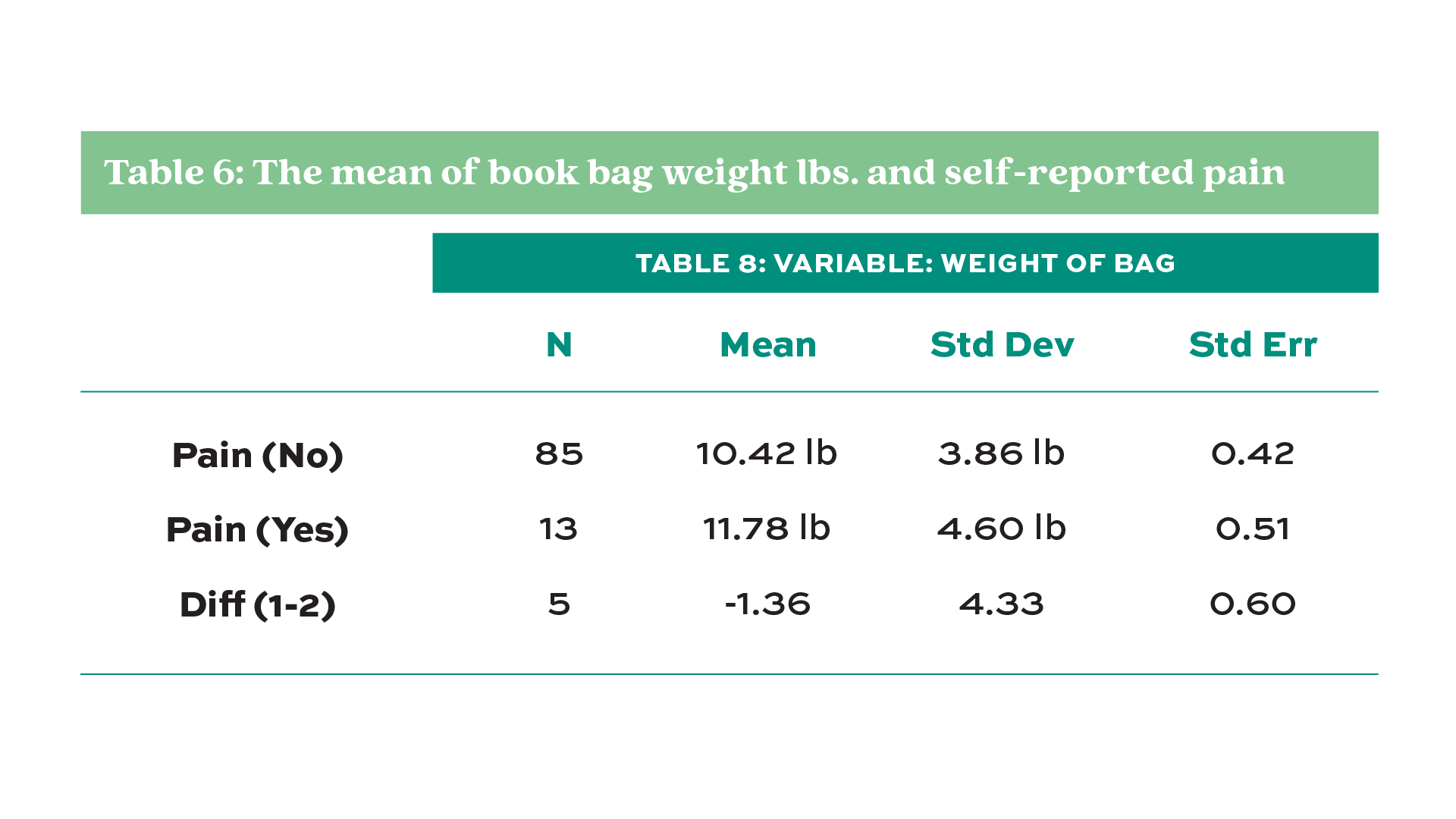
Table 7 shows no significant difference between one location and multiple locations by bag types among students who reported having pain, χ2 (1, N = 79) = 0.1062, p = 0.7445.

The relationship is tested by chi-square tests to indicate if there is a statically significant relationship in book bag weight by type of bag and self-reported pain by type of book bag.
The frequencies in bag weight shows significant difference, χ2 (1, N = 220) = 5.687, p = 0.0171. However, there was no significant difference in self-reported pain by the type of book bag, χ2 (1, N = 222) = 2.48, p = 0.1152.
Table 8 shows no significant difference between one location and multiple locations by bag types among students who reported having pain, χ2 (1, N = 79) = 0.1062, p = 0.7445.
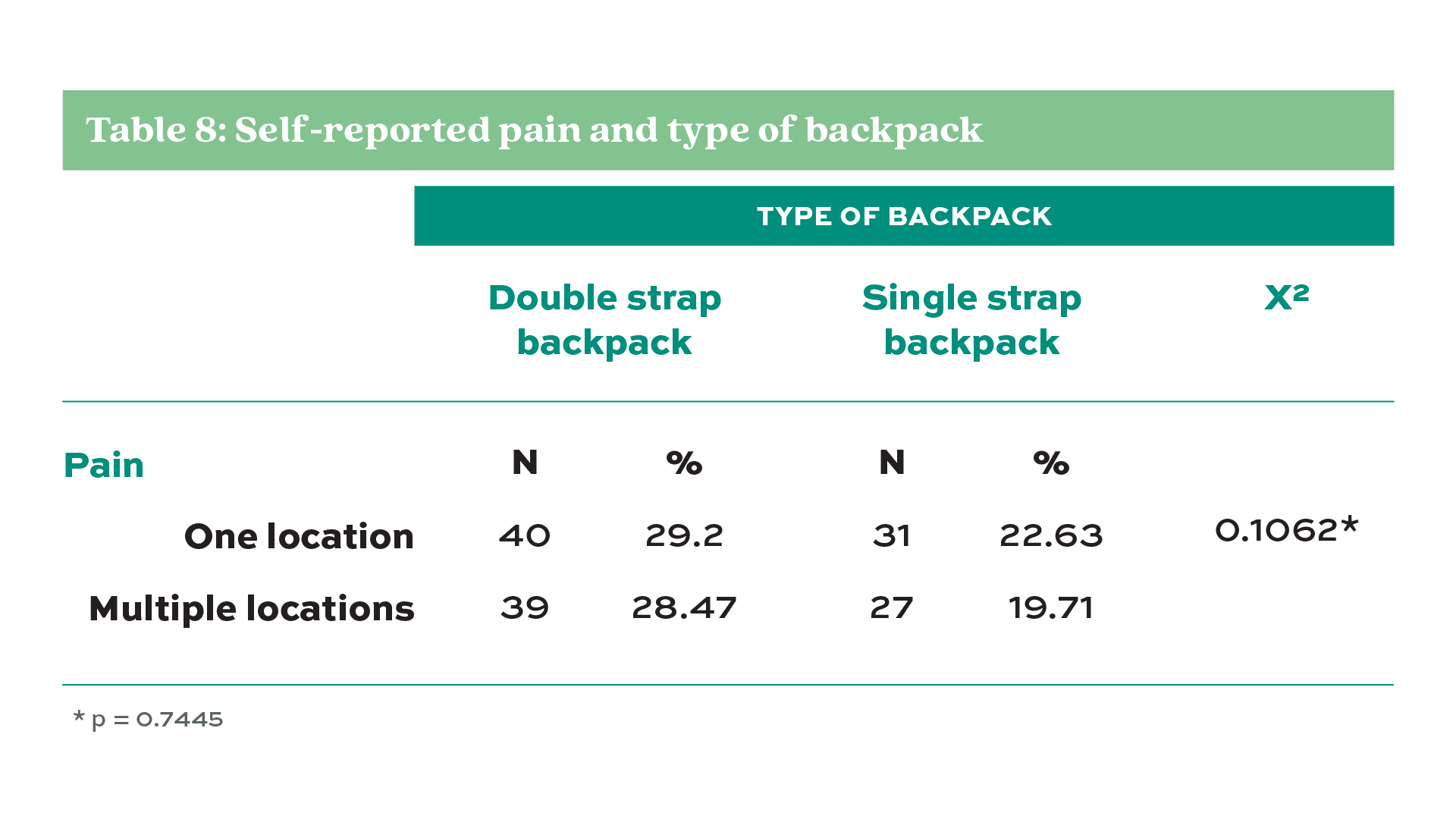
As indicated in Table 9, the data indicates a statistically significant difference (p= < 0.05) in reporting pain between residence types among students who answered “yes” in pain question, χ 2 (1, N = 137) = 6.2966, p= 0.0121.
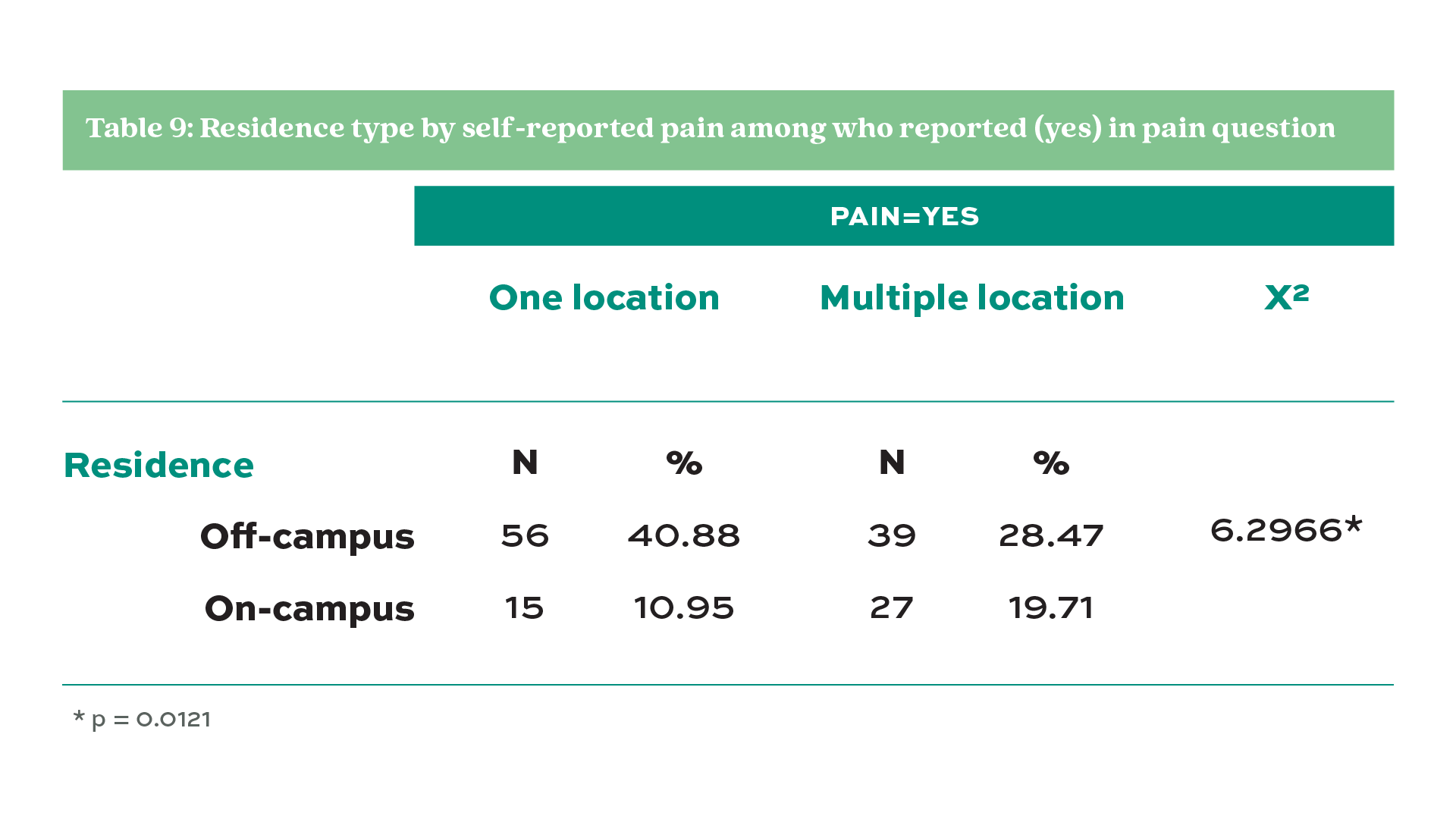
Discussion
From the 220 effective respondents, 90% of respondents carry a book bag four days or more per week—70% of respondents were undergraduate students, 60% of respondents wore the standard double strap adjustable book bag, and most of the students were full-time students. The average weight of the book bag students carry is 11.25 lbs., with standard deviation 4.37. Thirty eight percent of females and 23% of male respondents self-reported pain associated with book bag use. A chi-square test was used to determine whether there is a significant difference between self-reported pain by respondent gender. The difference between these variables was significant, χ 2 (1, N = 222) = 8.2019, p= 0.0042. Forty six percent of respondents reported pain in the shoulders, and 37% of respondents reported pain in the lower back. These locations have been examined in order to identify if the bag style associated with reporting pain correlates to one of these locations. A Fisher’s exact test was used to identify the differences between pain locations among students who reported one pain location by two types of bags—one strap and a two straps back (standard book bag). The results indicated a significant difference between the pain location (lower back), bag types (standard double strap), and the p-value for the Fisher’s exact test was p= 0.0013.
A t-test was used to identify if there is a statistically significant difference between the means of book bag weight for students who reported having pain and not having pain. The results in Table 7 indicate that there is a significant difference between the mean of book bag weight for students who reported having pain and not having pain (t (220)= -2.52, p = 0.0125). The mean of book bag weight for students who reported having pain (M= 12.24, SD= 5.92) is significantly higher than students who reported not having pain (M=10.42, SD= 3.86).
The relationship was tested by chi-square tests to indicate if there is a statically significant relationship between book bag weight by type of book bag and self-reported pain by type of book bag. The frequencies in bag weight shows significant difference, χ2 (1, N = 220) = 5.687, p = 0.0171. However, there was no significant difference in self-reported pain by the type of book bag, χ2 (1, N = 222) = 2.48, p = 0.1152. A chi-square was used to identify if students’ residence types correlates with self-reported pain. The categories are no pain, one pain location, and multiple pain locations for reporting pain, and the residence types are off-campus and on-campus. The results show a significant relationship between the variables, χ 2 (2, N = 222) = 6.3269, p= 0.0423. As indicated in Table 8, the data indicates a statistical difference (p= < 0.05) in reporting pain between residence types among students who answered “yes” in pain question, χ 2 (1, N = 137) = 6.2966, p= 0.0121
Conclusion
The purpose of this small-scale pilot study was twofold. First, identify risk factors (book bag style, gender, weight of book bag) associated with self-reported pain due to book bag carriage in a college setting and discuss strategies for prevention. Secondly, obtain preliminary data to determine feasibility of future large-scale studies. There are several significant findings associated with the study. These results suggest that risk factors such as gender, residence location (on- or off-campus), weight, and style of book bag may play a role in self-reported back pain among college students. More study is required to evaluate the frequency, magnitude, and duration of book bag carriage, and the compressive forces exerted on the body, specifically the spine. As mentioned in the study’s methods section, there were several limitations associated with the pilot study. Since this research was a pilot study, the researcher used the Center for Disease Control and Prevention’s definition of pain as a question in the survey instrument to examine self-reported pain. The study did not use a traditional pain intensity scale. As a result, it is difficult to make any statement about causality. However, according to other researchers, pain can be especially difficult to accurately measure as individuals have differences in thresholds of pain and the perception of pain can vary, even when using pain intensity scales. Based on the findings of this study, educators, health care professionals, and students should consider ways in which to reduce book bag weight carriage. In closing, this researcher contends that it is important to value the self-reporting of pain as early as possible to reduce any potential problems and refer them to medical attention as soon as possible. Self-perceived pain, regardless of the measurement system, may be a symptom of a serious medical condition.

References
Becker M, Nelson AJ, Rothman J, et al. (August 2003). Postural changes while sitting may trigger back pain. Biomechanical Magazine. 47-54.
Brackley HM, Stevenson JM. (2004). Are children’s backpack weight limits enough? A critical review of the relevant literature. Spine, 29(19), 2184-2190.
Dooley, David (1995). Social Research Methods 3d ed. Upper Saddle River, NJ: Pretice-Hall 125
Feldman DE, Rossignol M, Shrier I, Abenhaim L. (1999). A risk factor for the development of low back pain in adolescents. Spine, 24 (23), 2492-2496.
Guo HR, Tanaka S, Halperin WE, Cameron LL. (1999). Back pain prevalence in US industry and estimates of lost workdays. American Journal of Public Health, 89 (7), 1029-1035.
Grimmer KA, Williams MT, Gill T. (1999). The associations between adolescent head-on-neck posture, backpack weight, and anthropometric features. Spine, 24(21), 2262-2267.
Hamilton, A. (2001). Prevention of injuries from improper backpack use in children. Work, 16(2), 177–179.
Hong Y, Li JX, Wong ASH, Robinson PD. (2000). Effects of load carriage on heart rate, blood pressure and energy expenditure in children. Ergonomics, 43(6), 717-727.
Melzack R, Wall PD. The challenge of pain. 2nd ed. New York: Penguin Books; 1996.
Murphy S, Buckle P, Stubbs D. Classroom posture and self-reported back and neck pain in schoolchildren. (2004). Journal of Applied Ergonomics. 35 (2), 113–120.
Moore, Michael, White, Gregory, Moore, Donna (2007). Association of Relative Backpack Weight With Reported Pain, Pain Sites, Medical Utilization, and Lost School Time in Children and Adolescents. Journal of School Health. 77 (5), 232-239.
Pascoe, D. D., Pascoe, D. E., Wang, Y., & Shim, D. M. (1997). Influence of carrying book bags on gait cycle and posture of youths. Journal of Ergonomics, 40 (6), 631-641.
Johnson RF, Knapik JJ. (1995). Symptoms during load carrying effects of mass and load distribution during a 20-km road march. Journal of Perceptual and Motor Skills, 81(1), 331-338.
Troussier B, Davoine P, De Gaudemaris R, et al. (1994). Back pain in school children a study among 1178 pupils. Scandinavian Journal of Rehabilitation Medicine, 26 (3), 143-146.
Waters TR, Baron SL, Piacitelli LA, et al. (1999). Evaluation of the revised NIOSH lifting equation. A cross-sectional epidemiology study. Spine, (24)4, 386–394.
Whittfield J, Legg SJ, Hedderley DI. (2005). Schoolbag weight and musculoskeletal symptoms in New Zealand secondary schools. Journal of Applied Ergonomics, 36 (2), 193–198.


